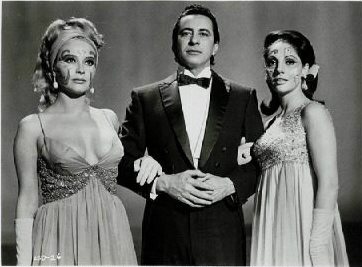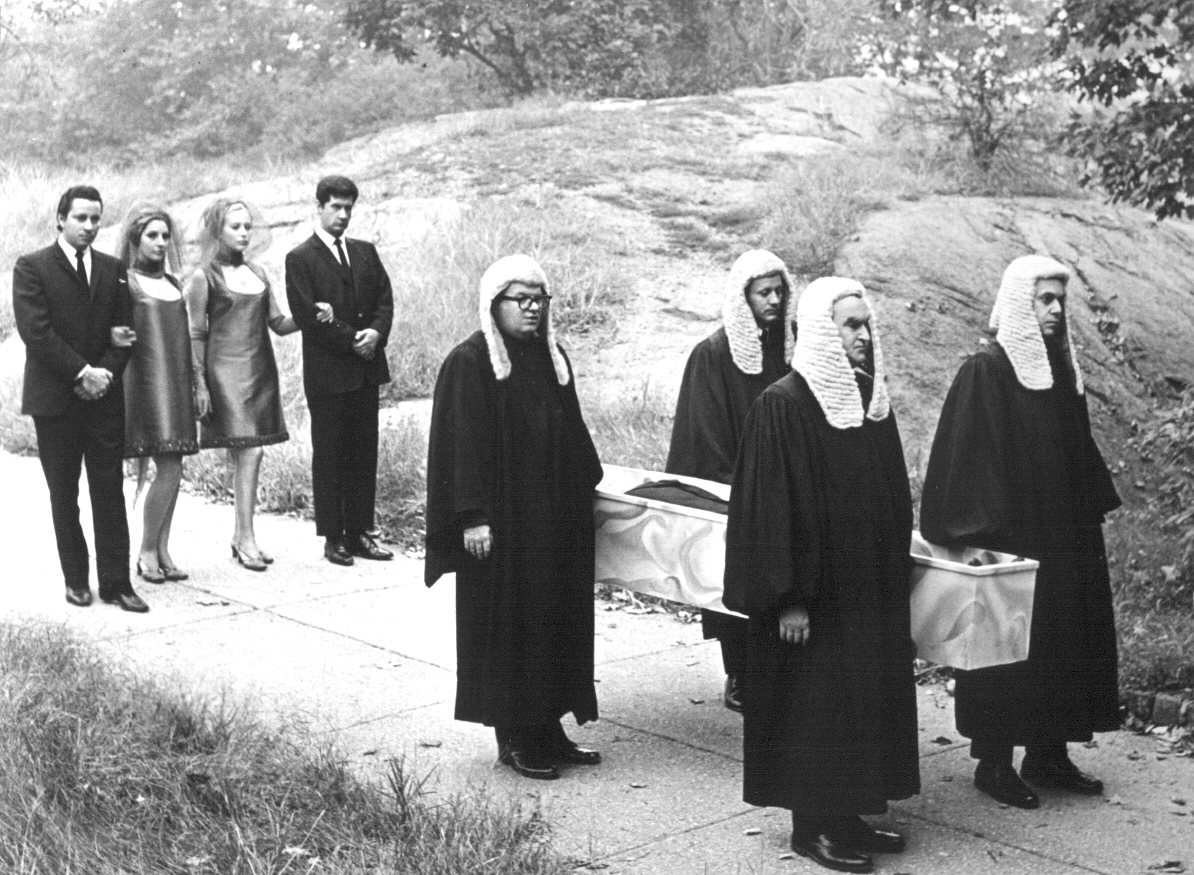

Un largo viaje hacia la muerte* [A Long Journey Towards Death] (Jesús Grovas L.-Filmex International Ltd.**, 1967) "Jesús Grovas S. presents..." Exec Prod: Adolfo Grovas S.; Prod: Robert I. Bergmann, Frank Marrero; Dir/Scr: José María Fernández Unsaín; Photo: Alex Phillips Jr.; Music: Raúl Lavista; Prod Mgr: Adrián Grovas S.; Prod Chief: Enrique Morfín (Mex), Felipe Rodríguez (NY); Sub-Dir: Manuel Ortega (Mex), Ed Wallace (NY); Film Ed: José W. Bustos; Art Dir: Manuel Fontanals (Mex), Randy Monk (NY); Decor: Adalberto López A.; Camera Op: Andrés Torres (Mex), Frank Calabria (NY); Lighting: Antonio Alvarez (Mex), Jim Dillinger (NY); Makeup: Concepción Zamora (Mex), Pete Garafola (NY); Titles: Toni Sbert; Tech Adv:: Slavo Vorkapich; Sound Supv: James L. Fields; Music Rec: Galdino Samperio; Sound Ed: Reynaldo Portillo; Union: STPC [the end title on the existing print seems to be from a different movie (!) and credits the STIC union!]
*posters for the film show the title as Un large viaje hacia la muerte (L.S.D.) but the initials do not appear on the main title of the movie itself.
**this was a Mexican-U.S. production. "Filmex International Ltd." was a U.S. company, possibly affiliated with the Mexican company of the same name.
Cast: Ignacio López Tarso (Dr. David), Fanny Cano (Eva), Jacqueline Andere (María), Miguel Ángel Alvarez (Juan), Giselle Kalli, Miriam Marrero, Bárbara Ransom (receptionist), Crista de Humbolt [sic] (Eva's neighbor), José "Chegui" Torres (detective), Gladys Rodríguez (Gladys)
Notes: sadly, current evaluation of this film is hampered by the horrible state of the available print(s). Since the mid-1980s (first the Madera video release, then a 1999 VHS version from Oxxo, apparently from the same source) Un largo viaje hacia la muerte has only been seen here via a horrible transfer--faded, at times out of focus, fuzzy--that is also cut by nearly 20 minutes (the running time of the video is 65 minutes, compared to 85-minute length cited in García Riera's Historia documental del cine mexicano).
The cuts include: a pre-credits sequence in which Miguel Ángel Alvarez's character is given electroshock, the actual murder of several nurses, López Tarso's comments about the effectiveness of LSD as a medical treatment, any "nudity" of Fanny Cano (I suspect it was only "show nothing" nudity anyway), at least one scene between López Tarso and "Chegui" Torres (a boxer playing a detective) and up to 6 minutes of the LSD sequence (García Riera says the "last 16 minutes" of the movie are taken up with this footage, but the video version has 10 minutes of "psychedelics" and another 3 minutes of "plot" before the end of the picture).
Juan undergoes shock treatment at the hands of Dr. David, and apparently is able to resume a "normal" life. He and his wife María make dolls in a workshop attached to their New York City apartment. However, Juan is not cured--he seeks out nurses and murders them. Finally, Juan kidnaps Eva, the nurse (and fiancee) of Dr. David, taking her to a secret basement studio, where he has created large, abstract statues.

Juan says he is going to kill Eva: "Dozens of times your fingers pressed the buttons that sent fire into my head, the electric current that shattered me." Eva replies: "It was a medical treatment. You were [pause] sick."
When Eva accuses Juan of being "crazy, crazy!" he says "I'm not a murderer, I'm a man with a mission," and adds he's "cleaning the world. " Before he kills her, Juan intends to carve her image in marble. María, worried that Juan has not returned home, tells Dr. David. Together they locate Juan just as he is preparing to strangle Eva.
Juan agrees to undergo treatment, this time a dose of LSD. [In the current, cut version, all discussion of the drug is omitted--there is a jump cut from Dr. David saving Eva to Juan on the couch in the doctor's office as he begins his "trip." Unless one knows what is happening, his subsequent hallucinations are incomprehensible.] When he returns to reality, Juan seems (temporarily) sane. He knows he is the murderer of the nurses, and while Dr. David, María and Eva say his case isn't hopeless, Juan thinks otherwise, and leaps out of the window of David's office, plunging numerous stories to his death on the sidewalk below.
The plot of Un largo viaje hacia la muerte references (and/or exploits) various contemporary topics, including LSD (also a plot device in 1968's The Big Cube, not to mention Hollywood pictures like The Trip), the Boston Strangler (Juan strangles his victims) and the 1966 mass slayings of nurses in Chicago by Richard Speck. Although today we tend to associate LSD with "hippies" taking "trips," the drug was originally considered for therapeutic use and Un largo viaje hacia la muerte--despite the "psychedelic" titles and certain parts of the LSD sequence--has nothing to do with the youth culture of the late Sixties.
Un large viaje hacia la muerte was filmed in New York City and Mexico City, beginning in October 1967. Most of the "dramatic" interiors seem to have been shot in the Churubusco studios, notably the scenes in Juan and María's apartment, Juan's secret studio, and David's office. Most of the NYC footage is exteriors, although at least three sequences--the first nurse's murder in a coffee shop bathroom, the second nurse's murder in her apartment, and a scene in the morgue--were clearly shot there as well. It's difficult to tell, but Miguel Ángel Alvarez, Ignacio López Tarso and Fanny Cano certainly made the trip to New York, but Jacqueline Andere (the director's wife) may have filmed all of her scenes in Mexico (Christa von Humboldt and Bárbara Ransom appear only in Mexican footage and "Chegui" Torres probably worked only in New York).

The production values are satisfactory, although the horrible quality of the video transfer ruins a lot of the movie's impact. Well-known experimental filmmaker Slavo Vorkapich receives credit as a "technical advisor"--he probably worked on the LSD sequence, which is filled with flashy, "psychedelic" visuals, such as spinning spirals, scenes in negative, and characters with painted faces. In one part, various women--made up to look like dolls--are lined up in giant display boxes and "die" as Juan walks past them. In another sequence, David whips Juan, saying "I'm every man in the world, punishing you." This section concludes with men (wearing old-fashioned judges' wigs and robes) carrying an open coffin through a park, as three children toss a beachball around. Although Juan's body is in the coffin, he is also walking behind it with David, María, and Eva.
The performances are all good: the four main players were experienced veterans and they play their roles straight. Special mention should be made of the music score, which is also fine.
Un largo viaje hacia la muerte is a curiosity piece, but in its current mutilated state it is difficult to judge it fairly. This a shame and it would be wonderful if a restored print would finally surface so this picture could be reevaluated.

